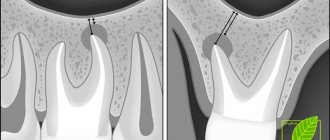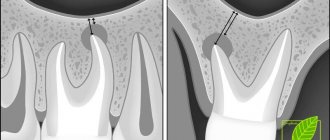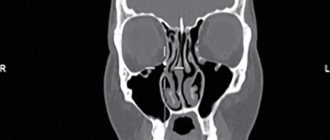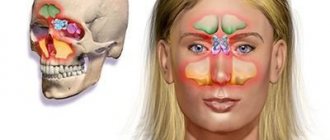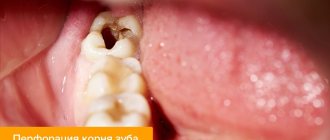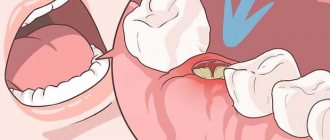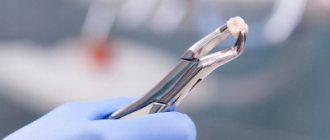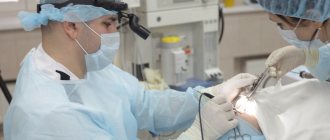Why can odontogenic sinusitis occur?
The maxillary (maxillary) sinus is a cavity with bony walls that is located inside the upper jaw. The cavity communicates with the nasal cavity through the anastomosis, which is located on the side wall of the sinus facing the nasal cavity. The lower wall has contact with the upper teeth. Quite often (in about 15% of cases) the apex of the tooth root lies directly under the mucous membrane of the bottom of the maxillary sinus, and there is no bone septum between them.
When an infection enters the maxillary sinus, inflammation of its mucous membrane or sinusitis occurs.
There are two ways of infection:
- rhinogenic - through the nasal cavity. In this case, the infection penetrates from the nasal cavity through natural or artificial (after surgery) communication;
- odontogenic - through the tooth or tissue around it.
Odontogenic sinusitis most often develops slowly against the background of chronic infection in the area of the tooth root. As a result of chronic inflammation, a cyst forms in the root area, which destroys the barrier between the sinus and the tooth. Pathogenic microbes gradually penetrate the sinus mucosa, causing inflammation.
Also, odontogenic sinusitis can occur as a result of the actions of the dentist. Often, after the removal of the upper tooth, the thin barrier between the sinus and the oral cavity may be damaged. As a result, a gateway for dental infection appears. In this case, the anatomical features of the patient with a thin bone septum between the sinus and the tooth root or its complete absence are of key importance.
Infection can occur when cleaning the canals and filling them. In some cases, the filling material gets inside the sinus, causing the formation of fungal sinusitis, and the zinc contained in the filling material promotes the growth of mold fungi (Aspergillus, Mucora). Also, odontogenic sinusitis can develop after the sinus lift procedure and the installation of dental implants in the upper jaw.
Clinical manifestations of perforation of the maxillary sinus floor
Signs of acute perforation of the floor of the maxillary sinus appear during the procedure or immediately after its completion:
- The appearance of foamy blood from the socket of an extracted tooth;
- The appearance of a characteristic whistle when an air stream enters the oral cavity from the maxillary sinus during the test.
If perforation of the maxillary sinus was not identified and repaired immediately after tooth extraction or other procedure, the following symptoms will occur in the coming days:
- Swelling of the cheek on the injured side;
- Inability to open your mouth normally;
- Nasal discharge mixed with Corvi;
- Nasal voice;
- A feeling of heaviness and fullness in the area of the damaged sinus.
Complications
With odontogenic sinusitis, a chronic inflammatory process occurs. Dental microflora appears in the sinus, not typical for the upper respiratory tract, which can destroy bone tissue. Due to the fact that the paranasal sinuses have contact with the orbit and brain, odontogenic sinusitis can lead to severe complications:
- intraorbital (orbital phlegmon, ophthalmitis, optic nerve neuritis);
- intracranial (meningitis, encephalitis, brain abscess).
Therefore, at the slightest suspicion of this disease, you should consult a doctor.
Treatment of the pathological process
Treatment depends on the severity of the observed pathological process. Typically, surgical intervention is not required in situations where the perforation was carried out during the extraction of a diseased tooth and was detected at the same moment. In this case, X-ray data should show the absence of an infectious process in the maxillary sinus.
If there are no fragments, filling material or infection in the wound, then in this situation the dentist tries to form a blood clot in the hole after tooth extraction and make sure that the resulting cavity is not susceptible to infection. For such purposes, a small gauze swab can be used, which is soaked in iodine solution. Iodine itself has good bactericidal properties, allowing you to quickly eliminate all pathogenic microorganisms.
Most often, such a tampon can self-fix in the resulting wound cavity after tooth extraction. Sometimes stitches are required on the gums, which are done directly by the dentist. Treatment with an iodine solution is carried out for six to seven days until granulation tissue forms, which allows the perforation to close.
The dentist can temporarily close the defect using a special hypoallergenic plate made of plastic. The plate itself is securely fixed to adjacent teeth using clasps. It carefully separates the cavities of the maxillary sinus and mouth, which in turn promotes rapid healing and regeneration of healthy tissue in the perforation area.
It is important to carry out preventive measures aimed at preventing the development of any inflammatory complications. After all, after tooth extraction during perforation, pathogenic microorganisms that can cause a serious inflammatory process can enter the wound surface.
Prevention lies in the mandatory use of anti-inflammatory drugs and antibiotics prescribed by the doctor; agents that have a vasoconstrictor effect are also used to stop bleeding.
If foreign bodies penetrate into the maxillary sinus during perforation (fragments of tooth roots, filling materials, implant perforation), treatment is carried out in a hospital setting. In severe cases, surgical interventions can be performed on the maxillary sinus with its further opening, during which tissue is cleansed and foreign bodies are removed. After sanitation, plastic closure of the resulting perforation is performed.
Treatment
The treatment of odontogenic sinusitis requires an integrated approach. As a rule, treatment requires the simultaneous participation of an otolaryngologist and a dentist. Isolated antibacterial and conservative therapy lead only to temporary relief of the condition and removal of the severity of the process.
For a complete recovery, it is necessary to eliminate the source of infection - remove or treat the causative tooth while simultaneously sanitizing the inflamed sinus.
In case of foreign inclusions in the sinus (filling material, sinus lifting material, fungal bodies), their complete removal is necessary. For this, endoscopic techniques are used. They allow you to remove these formations through the nasal cavity. If there is a connection between the sinus and the oral cavity (oroantral fistula), it must be closed using special bioinert collagen-based membranes and mucosal flaps.
Methods for diagnosing perforation of the maxillary sinus floor
During diagnosis, a comprehensive study and analysis of the typical clinical picture observed with perforation of the maxillary sinus is used. The condition of the tooth socket, the presence of air bubbles, nosebleeds, and pain are taken into account. X-ray diagnostics are also performed, which show the area of perforation with high accuracy.
The dentist can perform a probing procedure for a perforated canal or an extracted tooth using a thin medical probe. This helps to reliably understand that there is no bone bottom in the wound. The instrument itself must pass freely through soft tissue without encountering obstacles along the way.
X-rays of the sinuses can detect characteristic darkening in the images, which are formed as a result of the accumulation of blood clots. Among other things, X-rays can show filling material, implants, and fragments of dental roots. X-rays with a contrast agent are often taken to help clearly visualize the condition of the bone tissue and surrounding tissues.
In such situations, a contrast agent is introduced into the cavity through a perforation fistula. An additional method of instrumental diagnostics is computed tomography, which determines the degree of perforation and the presence of foreign bodies, such as tooth fragments or residual filling material. If perforation is suspected, general clinical tests are required, which can show the presence of a focal infection in the patient’s body.
What is sinusitis?
Sinusitis is an infectious-inflammatory process in the maxillary sinus, which is the main contraindication for bone grafting. Performing a sinus lift for sinusitis is not considered possible, since the main rule of any surgical intervention is violated - maintaining asepsis (sterility).
There are two types of inflammatory process:
- Rhinogenic. The infection spreads into the sinus from the nasal passages. The viral etiology of the disease predominates, as well as bacterial agents typical for respiratory pathologies.
- Odontogenic. The cause of sinusitis is a diseased tooth located in the upper jaw. The infection penetrates through the dental roots, which are involved in the process, or by perforating the sinus with the formation of a communication between it and the oral cavity.
Sinusitis can be acute or chronic, depending on the causes and timeliness of treatment. The chronic form is characterized by the proliferation of vegetations and develops with untimely or improper treatment of acute inflammation.
Clinic
Damage to the maxillary sinuses always begins with an acute inflammatory process, which is characterized by the following symptoms:
- copious greenish nasal discharge (with bacterial infection) or scanty serous discharge (with viral etiology);
- pain in the infraorbital region, especially when changing body position;
- headache (most often forehead);
- pain in the jaw is characteristic of odontogenic sinusitis.
The pathological process can be in one or two sinuses, and the clinical picture, accordingly, is localized on the affected side. The lack of adequate treatment leads to the development of a chronic form of the disease, which is characterized by a decrease in the intensity of clinical manifestations.
X-rays of the skull help to make a reliable diagnosis, where the maxillary sinuses and their contents are clearly visualized. Normally they are completely airy.
Treatment
Therapeutic measures to eliminate the inflammatory process can be conservative or surgical. Treatment with antibacterial drugs and anti-inflammatory drugs is carried out within several days after diagnosis. In the absence of positive dynamics, an operation is performed - maxillary sinusotomy.
The essence of the manipulation is to create a hole in the wall of the affected sinus. Through it, the doctor drains the cavity (removing purulent contents) and administers medications to directly influence pathogenic agents. Such manipulation does not always require hospitalization, but lasts only a few minutes.
There is an opinion that performing a maxillary sinusotomy can lead to a chronic process, which is why patients have to constantly repeat this manipulation. The emergence of such fear is due to the fact that surgical treatment is carried out in advanced cases, when a full cure is no longer possible.
